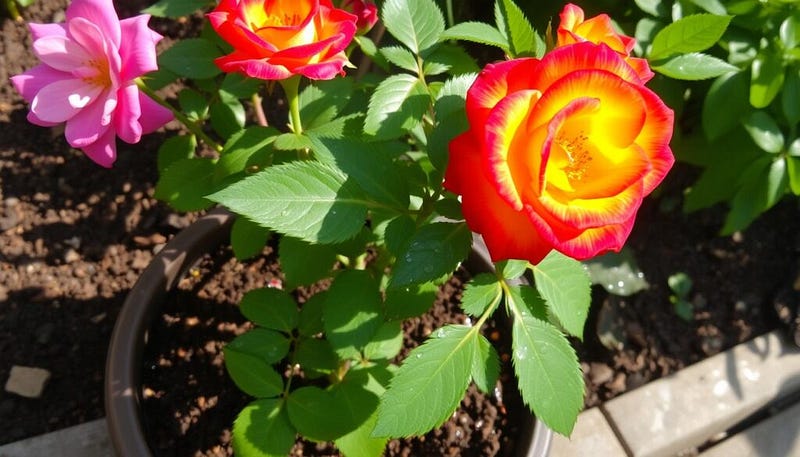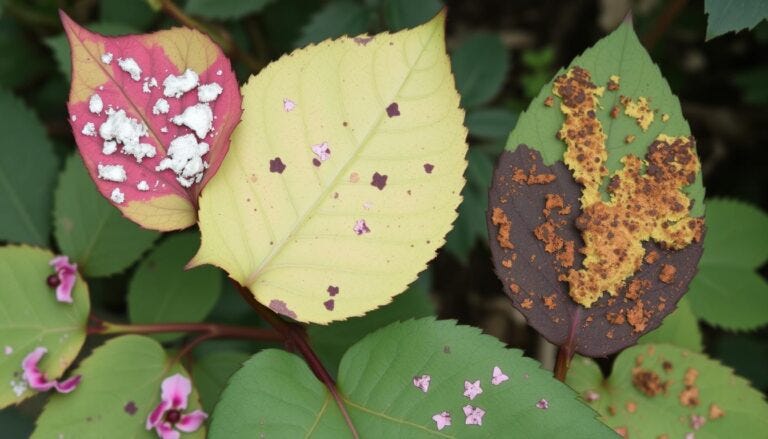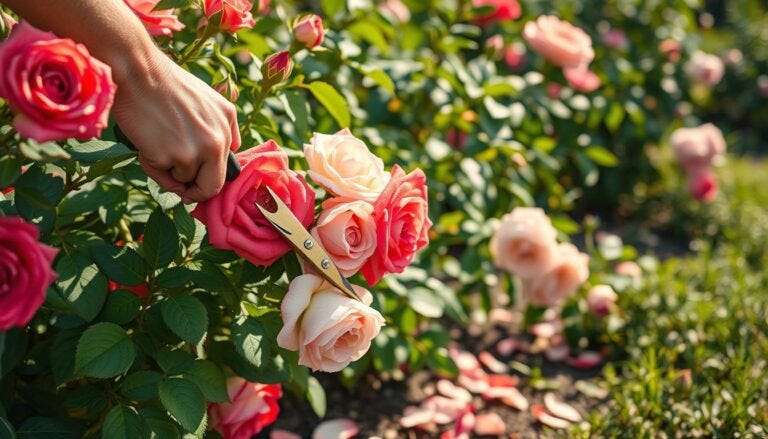Why Is My Rose Pot Plant Drying Out? Causes & Solutions
If you love roses, you might have seen your potted roses drying out. Their leaves wilt and turn yellow. It’s puzzling, especially if the soil looks wet. What’s causing this, and how can you fix it? Let’s explore the reasons and find ways to make your plants healthy again.
Key Takeaways
- Understanding the signs of a dying rose plant is crucial to identifying the underlying issues.
- Proper watering techniques, soil moisture management, and sunlight requirements are essential for maintaining healthy potted roses.
- Addressing factors like container size, fertilization needs, and pest/disease problems can help prevent drying out in rose pot plants.
- Implementing the right pruning and maintenance practices can revive a dried-out rose plant and promote its long-term recovery.
- Monitoring environmental conditions, such as temperature and humidity, is key to creating the optimal growing environment for potted roses.
Understanding the Signs of a Dying Rose Plant
Knowing when a rose plant is dying is key to saving it. Roses need a break of 4–6 weeks each year, but you must tell if it’s just resting or really struggling. Look for signs and check the roots to see if your rose is okay or needs help.
Common Visual Indicators
Wilting, yellow leaves, and dry, crisp foliage are clear signs of trouble. These signs mean the plant isn’t getting enough water and nutrients.
Distinguishing Between Dormancy and Death
To see if your rose is just sleeping or in trouble, cut a cane with a sharp knife. If you find green inside, it’s just resting. But if it’s brown and dead, your rose needs help fast.
Checking Root Health
For potted roses, look at the roots to understand its health. White, many roots mean it’s doing well. But brown, shriveled roots show it’s in trouble. Taking the plant out of its pot to check the roots can guide you on what to do next.
By watching for early signs of trouble, you can act quickly to save your rose. With careful observation and a little care, your roses can bounce back and flourish again.
Why Is My Rose Pot Plant Drying Out
Potted rose plants can dry out for many reasons. These include wrong watering, bad soil moisture, too much sun, small pots, and stress. Knowing these causes helps fix the problem.
One big reason is not watering enough. Roses need lots of water, about 2–3 gallons twice a week. Without enough, they wilt, especially in hot or windy places.
Too much water can also dry out a rose plant. This can cause root rot and stop the plant from getting water. Signs of too much water include wilting, even when the soil is wet.
- Roses in small pots with brown or shriveled roots have a higher chance of being dead.
- Overwatering can lead to wilting in roses, particularly in arid, hot climates, and areas with windy conditions.
- Roses appreciate deep, infrequent watering, suggesting watering with 2–3 gallons twice per week.
Not enough sunlight can also dry out a rose plant. Roses love full sun but too much heat can dry them out. It’s important to find the right spot with enough sun and protection from extreme weather.
The size of the pot also matters. Smaller pots dry out faster, while bigger ones hold more moisture. Moving a dried-out rose to a bigger pot might help it come back to life.
The Impact of Watering Practices on Potted Roses
Watering your potted roses right is key to their health. Too little or too much water can harm them. Knowing the signs of underwatering and overwatering helps. It also guides you in watering them just right.
Signs of Underwatering
Roses that don’t get enough water have dry, crisp leaves. They wilt and their leaves turn grayish-green. If ignored, these plants can die.
Symptoms of Overwatering
Too much water is bad for potted roses too. Their leaves are soft and droopy, not dry. They may turn yellow and fall off.
Proper Watering Techniques
- Water your potted roses deeply and infrequently, about 2–3 gallons of water twice a week.
- Check the soil moisture by pushing your finger 2 inches into the soil. If the soil feels dry, it’s time to water again.
- Potted roses that have dried out can be rehydrated by placing the entire pot in a larger bucket of water until the soil is fully saturated.
By using these watering tips, your potted roses will get the right amount of water. They’ll thrive and bloom beautifully.
Soil Moisture Management for Potted Roses
Keeping the soil just right is key for your potted roses to do well. The right amount of moisture can turn a struggling rose into a blooming beauty. Let’s look at some ways to keep your roses happy and healthy.
Using mulch is a smart move. Mulch keeps the soil moist longer and soaks up extra water. If your soil gets too wet, just pull back the mulch. This lets the soil dry a bit.
It’s also important to check the soil moisture often. Too much or too little water can harm your roses. Keeping the moisture just right helps your roses grow strong and bloom beautifully.

Remember, rose potting mix and soil moisture are closely linked. By learning how to manage soil moisture, you’ll grow stunning potted roses. They’ll bring joy to your garden for many seasons.
Sunlight Requirements and Location Factors
Roses need the right amount of sunlight to grow well. They should get 6–8 hours of direct sunlight each day. Some roses can handle partial shade, making them good for less sunny spots.
Optimal Sun Exposure
Roses come in different types, each with its own sunlight needs. Sunlight for roses is key to getting lots of blooms. Make sure your rose gets the sunlight it needs based on its type.
Protection from Intense Heat
Roses love sunny spots but can get hurt by too much sun, especially in the afternoon. This can burn their leaves, especially if they’re light-colored. To keep your roses safe, give them some shade during the hottest part of the day.
Choosing the Right Rose Plant Location
When picking a spot for your potted roses, look for the right mix of sunlight and shade. Find a place that gets enough sun but also protects from the hottest sun. Good air flow in the area can also help keep your roses cool.
Finding the perfect spot for your roses is key to their happiness. By balancing sun and shade, you can make your roses bloom beautifully.
Container Size and Root Health
Keeping your potted roses healthy means thinking about their pot size. As they grow, their roots can get cramped in small pots. This can make the plant sick and reduce the number of flowers it blooms. It’s key to move them to bigger pots every 3–4 years to let their roots grow well.
Choosing the right pot for your roses is important. Look for one that lets roots grow and drains well. A good pot is 2 to 2.5 feet deep and 15 to 20 inches wide. This size gives roots room to spread and get the nutrients they need for healthy growth and lots of flowers.
Having the right pot size is vital for your potted roses. Along with good soil and watering, it helps them stay healthy and bloom well. By giving your roses the right rose container size, they can thrive and give you lots of beautiful flowers.
Understanding Fertilization Needs
Proper fertilization is key for your rose pot plants’ health. Roses need a mix of nutrients to grow well. Knowing when to fertilize and how to avoid too much can help your garden bloom.
Signs of Over-fertilization
Too much fertilizer can harm your roses. Watch for signs like root burn and yellow leaves with brown edges. These show your plants are getting too much of some nutrients.
Nutrient Deficiency Symptoms
Not getting enough nutrients can also hurt your roses. Look for slow growth and no blooms. These are signs your plants need more nitrogen, phosphorus, or potassium.
Fertilization Schedule
- Fertilize your rose pot plants three times a year: in the spring, midsummer, and late summer.
- Use organic fertilizers with a balanced NPK (nitrogen-phosphorus-potassium) ratio to provide a steady, controlled release of essential nutrients.
- Avoid fertilizing newly planted roses during their first year, as they need time to establish a strong root system before heavy feeding.
Understanding rose nutrition and fertilizing regularly can make your potted roses bloom beautifully. They will have vibrant colors and lush leaves all season.
Soil Quality and pH Balance
Roses love slightly acidic, well-drained soil with a pH of 6–7. The best soil mix is ⅓ sand, ⅓ silt, and ⅓ clay. This mix is perfect for your rose pot plant. Knowing the right rose soil pH and soil quality for roses is key to their growth.
First, test your soil to find its pH and check for nutrients. If your soil is too heavy, add organic compost to help it drain better. Use pine needle mulch or garden lime to adjust the pH for your roses.
- Ideal rose soil pH range: 6–7
- Rich, loamy soil with ⅓ sand, ⅓ silt, ⅓ clay is best
- Conduct a soil test to assess pH and nutrient levels
- Amend heavy, compacted soil with organic compost
- Use pine needle mulch or garden lime to adjust pH as needed
Keeping the right soil quality for roses is vital for their health. By knowing the best pH and adding the right soil, your rose pot plant will flourish.

“Healthy soil is the foundation for thriving roses. Take the time to get your soil right, and your roses will reward you with beautiful blooms.”
Common Pest Problems in Potted Roses
Potted rose plants face many pests that harm their health and look. Aphids, sawfly larvae, spider mites, and Japanese beetles are common culprits. Knowing these pests and using natural control methods is key to keeping roses healthy in pots.
Identifying Harmful Insects
Some major pests of roses include:
- Aphids: Tiny, pear-shaped, and fast-reproducing, they suck the life from roses.
- Sawfly larvae: Look like small caterpillars and eat rose leaves, leaving them with a lace-like look.
- Spider mites: Tiny, thrive in hot, dry places, and eat a lot, weakening plants.
- Japanese beetles: Half-inch long, eat rose buds and flowers, leaving leaves bare.
- Thrips: Slender, about 1/16 inch long, cause color changes and scarring on rose petals.
Natural Pest Control Methods
Instead of harsh chemicals, gardeners can use natural ways to fight pests:
- Water sprays can knock off aphids, mites, and other pests.
- Removing pests by hand, like Japanese beetles or sawfly larvae.
- Attracting good bugs like ladybugs and lacewings that eat pests.
- Using organic insecticidal soaps or horticultural oils to kill bugs.
- Applying Bacillus thuringiensis (Bt) to fight caterpillars and grubs.
Prevention Strategies
Keeping potted rose plants healthy is key to avoiding pests. Good watering, rich soil, and enough sunlight help roses fight off pests. Regular checks and quick action when pests are spotted are also vital to prevent damage.
Dealing with Fungal Diseases
Fungal diseases like black spots and powdery mildew are common in roses. Black spot causes yellow leaves with brown spots. Powdery mildew looks like a white fuzzy coating on leaves.
To stop these diseases, water your rose plant at the base. Make sure there’s air around it. Choose roses that resist disease well. Watering in the morning helps avoid powdery mildew.
If your rose gets sick, cut off the bad leaves first. A baking soda spray can help too. But, use chemicals only when needed to protect the environment and soil.
Rose varieties differ in their fight against fungal diseases. Choosing the right one helps a lot. Good drainage and regular water also help fight diseases.
Keep your rose in the best conditions. Good air and sunlight help prevent diseases.
“Fungal pathogens account for 85 percent of all plant diseases, according to Michigan State University Extension.”
Stay alert and act fast to manage black spots on roses and other fungal problems. This way, your roses will stay healthy and beautiful.

Temperature and Humidity Considerations
Growing roses in pots needs a balance of temperature and humidity. Roses do best in certain conditions. Knowing these is key to keeping your potted plants healthy and long-lasting.
Ideal Growing Conditions
The best temperature for potted roses is 60–70 degrees Fahrenheit. This warm range helps them grow strong and bloom well. They need 6–8 hours of direct sunlight a day to thrive, preferring sunny but sheltered spots.
In summer, potted roses may need water every day to stay moist. Pots don’t protect well against heat. In cooler times, water them once or twice a week, based on humidity and temperature.
Managing Environmental Stress
Extreme temperatures can stress potted roses a lot. Sudden weather changes can cause wilting, color changes, and even death. To avoid this, provide shelter like moving pots to shaded spots in heat or insulating them in winter.
Keeping humidity between 60–80% is also vital for potted roses. Dry air can make leaves curl and tips brown. Too much moisture can cause fungal problems and root rot. Using humidifiers, misting, and good ventilation can help create a good environment for your roses.
By knowing the right conditions for roses and managing temperature and humidity, you can make your potted garden bloom beautifully. This will give you vibrant, fragrant flowers all season long.
Pruning and Maintenance Tips
Proper pruning and regular maintenance are key for your rose plant’s health and blooms. Whether it’s a miniature rose in a pot or a larger variety in your garden, these rose pruning techniques and rose plant maintenance tips will help. They ensure your rose thrives.
Pruning for Optimal Shape and Airflow
Prune your rose plant to get a vase shape with an open center. This improves air circulation, preventing disease and promoting growth. Always use clean, sanitized pruning shears to avoid spreading infections.
Regular Maintenance Tasks
- Deadhead spent blooms regularly to encourage new flower production.
- Remove any fallen leaves, petals, or other debris around the base of the plant to deter pests and diseases.
- Monitor for signs of pest infestations or fungal issues, and address them promptly with appropriate organic treatments.
By following these rose pruning techniques and rose plant maintenance practices, your potted rose will thrive. It will reward you with stunning blooms all season.
Proper Timing for Pruning
The best time to prune roses is in late winter or early spring, when they’re dormant. This lets them recover and focus on new growth and flowers. Avoid pruning in the peak of summer, as it can stress the plant and reduce blooms.

“Proper pruning is essential for the long-term health and beauty of your rose plants. By taking the time to shape and maintain them, you’ll be rewarded with a stunning display of blooms for years to come.”
Solutions for Reviving a Dried-Out Rose Plant
Seeing your rose plant dry out can be upsetting. But, with the right care, you can bring it back to life. The first step is to find out why it dried out and then fix it.
Emergency Care Steps
Start by giving your rose a deep soak. Water it slowly around the base to make sure it drinks well. This helps the roots and stem get water again, stopping more drying.
If it’s too sunny, move it to a shadier spot. Roses need 6 to 8 hours of sun a day, so protect them from too much heat.
Long-term Recovery Strategies
- Change how you water it. Water your rose bush about 2 times a week when the soil is dry. Don’t let the soil get too dry.
- Make the soil better by adding compost. This helps the soil keep water and gives your reviving dried-out roses the nutrients they need.
- Fix any pest or disease problems. Good pest and disease control helps your rose plant recovery.
Recovery takes time, especially if the damage is bad. But, with steady care, your rose can look healthy again.
Conclusion
Keeping rose pot plants healthy and thriving is key. Understanding the factors that affect their well-being is crucial. By tackling issues like drying out, your roses can bloom beautifully all season.
Proper rose pot plant care is essential to prevent drying out. This includes the right watering, soil, and sunlight. Also, managing pests, diseases, and stress helps keep your roses healthy.
With the right knowledge and care, you can enjoy your potted roses. This article provides the guidance you need. Follow it to keep your roses vibrant and thriving for years.



Comments
Post a Comment